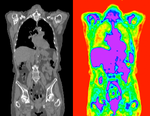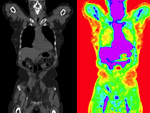Difference between revisions of "Documentation:Nightly:Registration:RegistrationLibrary:RegLib C20"
From Slicer Wiki
| Line 32: | Line 32: | ||
== Procedure == | == Procedure == | ||
It is possible to perform both steps of affine and BSpline registration in a single pass within the [[Documentation/Nightly/Modules/BRAINSFit|''General Registration (BRAINS)'' module]], but to better show/judge progress we perform each separately and feed the results of one the the next step. Hence we first run an affine registration, then use that as starting point for a BSpline registration. | It is possible to perform both steps of affine and BSpline registration in a single pass within the [[Documentation/Nightly/Modules/BRAINSFit|''General Registration (BRAINS)'' module]], but to better show/judge progress we perform each separately and feed the results of one the the next step. Hence we first run an affine registration, then use that as starting point for a BSpline registration. | ||
| − | #'''Load & Center Volumes''': | + | #'''Load & Center Volumes''': [[Media:RegLib_C20_1_DisplayAndCenter.mov|(screencast for this step)]] |
##the original unregistered PET/CT pair have very different image origins. When loaded into Slicer there is very little overlap between the two sets. We first re-center all the volumes to correct for this. Alternatively you can select the "Center Volume" option in the File dialog when loading the images. | ##the original unregistered PET/CT pair have very different image origins. When loaded into Slicer there is very little overlap between the two sets. We first re-center all the volumes to correct for this. Alternatively you can select the "Center Volume" option in the File dialog when loading the images. | ||
##open to the [[Documentation/Nightly/Modules/Volumes|''Volumes'' module]] | ##open to the [[Documentation/Nightly/Modules/Volumes|''Volumes'' module]] | ||
| Line 46: | Line 46: | ||
###for "PET_1" and "PET_2" select the "PET" preset (3rd from the left) | ###for "PET_1" and "PET_2" select the "PET" preset (3rd from the left) | ||
###since zero in the PET colormap is red, we set a threshold to suppress this: from ''Threshold'' menu, select "Manual" and set the left/lower threshold to ~ 600. You can also drag the pop-up slider until most of the red background turns to black. | ###since zero in the PET colormap is red, we set a threshold to suppress this: from ''Threshold'' menu, select "Manual" and set the left/lower threshold to ~ 600. You can also drag the pop-up slider until most of the red background turns to black. | ||
| − | #'''Compute Affine Registration''': open to the [[Documentation/Nightly/Modules/BRAINSFit|''General Registration (BRAINS)'' module]] | + | #'''Register: Compute Affine Registration''': [[Media:RegLib_C20_2_RegisterCT.mov|(screencast for this step)]] |
| + | ##open to the [[Documentation/Nightly/Modules/BRAINSFit|''General Registration (BRAINS)'' module]] | ||
##''Input Images: Fixed Image Volume'': CT_1 | ##''Input Images: Fixed Image Volume'': CT_1 | ||
##''Input Images: Moving Image Volume'': CT_2 | ##''Input Images: Moving Image Volume'': CT_2 | ||
| Line 63: | Line 64: | ||
###switch to the [[Documentation/Nightly/Modules/Data|''Data'' module]], verify that the "CT_2" node is inside the newly created "Xf1_Affine" node. The registration module should do that automatically for you. You may see a small "+" next to the "Xf1_Affine" node, click on it to reveal the contents. | ###switch to the [[Documentation/Nightly/Modules/Data|''Data'' module]], verify that the "CT_2" node is inside the newly created "Xf1_Affine" node. The registration module should do that automatically for you. You may see a small "+" next to the "Xf1_Affine" node, click on it to reveal the contents. | ||
###fade between background and foreground to judge the alignment. | ###fade between background and foreground to judge the alignment. | ||
| − | #'''Compute BSpline Registration''': return to the [[Documentation/Nightly/Modules/BRAINSFit|''General Registration (BRAINS)'' module]] | + | #'''Compute BSpline Registration''': [[Media:RegLib_C20_2_RegisterCT.mov|(screencast for this step)]] |
| + | ##return to the [[Documentation/Nightly/Modules/BRAINSFit|''General Registration (BRAINS)'' module]] | ||
##''Input Images: Fixed Image Volume'': CT_1 | ##''Input Images: Fixed Image Volume'': CT_1 | ||
##''Input Images: Moving Image Volume'': CT_2 | ##''Input Images: Moving Image Volume'': CT_2 | ||
| Line 81: | Line 83: | ||
###Place "CT_1" in the background and "CT_2_Xf2" in the foreground | ###Place "CT_1" in the background and "CT_2_Xf2" in the foreground | ||
###fade between background and foreground to judge the alignment. | ###fade between background and foreground to judge the alignment. | ||
| − | #'''Apply transform to PET''': | + | #'''Apply transform to PET''': [[Media:RegLib_C20_3_ApplyTransformToPET.mov|(screencast for this step)]] |
##open the [[Documentation/Nightly/Modules/BRAINSResample|''Registration / Resample Volume (BRAINS)'' module]] | ##open the [[Documentation/Nightly/Modules/BRAINSResample|''Registration / Resample Volume (BRAINS)'' module]] | ||
##''Image To Warp: PET_2 | ##''Image To Warp: PET_2 | ||
| Line 94: | Line 96: | ||
###''Window/Level editor presets'': click on the "PET" preset (3rd button from the left) | ###''Window/Level editor presets'': click on the "PET" preset (3rd button from the left) | ||
###from ''Threshold'' menu, select "Manual" and set the left/lower threshold to ~ 600. You can also drag the pop-up slider until most of the red background turns to black. | ###from ''Threshold'' menu, select "Manual" and set the left/lower threshold to ~ 600. You can also drag the pop-up slider until most of the red background turns to black. | ||
| − | #'''optional: Visualize Deformation''': install | + | #'''optional: Visualize Deformation''': install the '' [[Documentation/Nightly/Extensions/TransformVisualizer| ''TransformVisualizer'']]: [[Media:RegLib_C20_4_InstallTransformVisualizer.mov|(screencast for this step)]] |
##open the [[Documentation/Nightly/SlicerApplication/ExtensionsManager| ''ExtensionsManager'']] [[Image:ExtensionManagerIcon.png|50px]] | ##open the [[Documentation/Nightly/SlicerApplication/ExtensionsManager| ''ExtensionsManager'']] [[Image:ExtensionManagerIcon.png|50px]] | ||
##locate the ''Transform Visualizer" extension. Click on the "Install" button | ##locate the ''Transform Visualizer" extension. Click on the "Install" button | ||
##you will need to restart Slicer to complete the installation. '''Make sure to save all your work before restarting.''' | ##you will need to restart Slicer to complete the installation. '''Make sure to save all your work before restarting.''' | ||
| + | [[Media:RegLib_C20_4_InstallTransformVisualizer.mov|(screencast for this step)]] | ||
| + | #'''optional: Visualize Deformation''': use the '' [[Documentation/Nightly/Extensions/TransformVisualizer| ''TransformVisualizer'']]: [[Media:RegLib_C20_5_UseTransformVisualizer.mov|(screencast for this step)]] | ||
##upon restart, reload "CT1" and "Xf2_BSpline" | ##upon restart, reload "CT1" and "Xf2_BSpline" | ||
##to allow fast interactive use we need to subsample the large CT volumes: | ##to allow fast interactive use we need to subsample the large CT volumes: | ||
Revision as of 17:37, 28 August 2013
Home < Documentation:Nightly:Registration:RegistrationLibrary:RegLib C20Contents
Slicer Registration Library Case #20: Align PET/CT pair follow-up to baseline
Input
| fixed image/target baseline PET/CT |
moving image follow-up PET/CT |
Modules used
Download (from NAMIC MIDAS)
Screencasts / Video
- Loading volumes, setting colormaps, centering volumes
- perform affine and BSpline registration of the CT volumes
- apply the BSpline transform to the PET
- optional: install TransformVisualizer extension module
- optional: use TransformVisualizer extension module] to visualize the registration deformation field
Keywords
PET/CT, full-body, intra-subject, nonrigid
Procedure
It is possible to perform both steps of affine and BSpline registration in a single pass within the General Registration (BRAINS) module, but to better show/judge progress we perform each separately and feed the results of one the the next step. Hence we first run an affine registration, then use that as starting point for a BSpline registration.
- Load & Center Volumes: (screencast for this step)
- the original unregistered PET/CT pair have very different image origins. When loaded into Slicer there is very little overlap between the two sets. We first re-center all the volumes to correct for this. Alternatively you can select the "Center Volume" option in the File dialog when loading the images.
- open to the Volumes module
- Active Volume: CT_1
- scroll down and click on the Center Volume button.
- repeat for "CT_2", "PET_1" and "PET_2" volumes
- Set the display properties:
- the CT and PET have very distinct colormaps. Slicer provides presets for both types
- open to the Volumes module
- Active Volume: CT_1
- Window/Level editor presets: click on the "CT-abdomen" button (3rd from the right).
- repeat for volume "CT_2"
- for "PET_1" and "PET_2" select the "PET" preset (3rd from the left)
- since zero in the PET colormap is red, we set a threshold to suppress this: from Threshold menu, select "Manual" and set the left/lower threshold to ~ 600. You can also drag the pop-up slider until most of the red background turns to black.
- Register: Compute Affine Registration: (screencast for this step)
- open to the General Registration (BRAINS) module
- Input Images: Fixed Image Volume: CT_1
- Input Images: Moving Image Volume: CT_2
- Output Settings:
- Slicer Linear Transform: (create new transform, rename to: "Xf1_Affine")
- Output Image Volume: none (we need no resampled volume at this stage, only the transform)
- Initialization: none
- Initialize Transform Mode: switch to Off (there is sufficient overlap)
- Registration Phases: 'check Rigid, Rigid+Scale and Affine only
- Main Parameters:
- increase Number Of Samples to at least 200,000
- Leave all other settings at default
- click: Apply; runtime < 2 min.
- check the result
- Place "CT_1" in the background and "CT_2" in the foreground
- switch to the Data module, verify that the "CT_2" node is inside the newly created "Xf1_Affine" node. The registration module should do that automatically for you. You may see a small "+" next to the "Xf1_Affine" node, click on it to reveal the contents.
- fade between background and foreground to judge the alignment.
- Compute BSpline Registration: (screencast for this step)
- return to the General Registration (BRAINS) module
- Input Images: Fixed Image Volume: CT_1
- Input Images: Moving Image Volume: CT_2
- Output Settings:
- Slicer BSpline Transform: Create and rename new. Rename to "Xf2_BSpline"
- Slicer Linear Transform: set to none
- Output Image Volume: Create and rename new. Rename to "CT_2_Xf2" (we need a resampled volume to visualize the result. Nonrigid transforms cannot be visualized on the fly)
- Initialization: for the Initialization transform select the "Xf1_Affine" transform created above.
- Initialize Transform Mode: switch to Off
- Registration Phases: uncheck Rigid+Scale and Affine and select BSpline only
- Main Parameters:
- increase Number Of Samples to 300,000
- set B-Spline Grid Size to 11,11,7
- Leave all other settings at default
- click: Apply; runtime for this will be more than 1 minute, depending on CPU.
- check the result
- Place "CT_1" in the background and "CT_2_Xf2" in the foreground
- fade between background and foreground to judge the alignment.
- Apply transform to PET: (screencast for this step)
- open the Registration / Resample Volume (BRAINS) module
- Image To Warp: PET_2
- Reference Image: PET_1
- Pixel Type: short
- Warping Parameters / Transform file: "Xf2_BSpline"
- Output Image: create and rename new: "PET_2_Xf2"
- Leave all other settings at default
- click: Apply
- Go to the Volumes module and set the PET colormap and threshold for the new volume:
- Active Volume: PET_2_Xf2
- Window/Level editor presets: click on the "PET" preset (3rd button from the left)
- from Threshold menu, select "Manual" and set the left/lower threshold to ~ 600. You can also drag the pop-up slider until most of the red background turns to black.
- optional: Visualize Deformation: install the TransformVisualizer: (screencast for this step)
- open the ExtensionsManager

- locate the Transform Visualizer" extension. Click on the "Install" button
- you will need to restart Slicer to complete the installation. Make sure to save all your work before restarting.
- open the ExtensionsManager
- optional: Visualize Deformation: use the TransformVisualizer: (screencast for this step)
- upon restart, reload "CT1" and "Xf2_BSpline"
- to allow fast interactive use we need to subsample the large CT volumes:
- Go to the Registration / Resize Image (BRAINS) module
- Image To Warp: CT_1
- 'Output Image: create & rename new: CT_1s
- Pixel Type: short
- Scale Factor: 3
- Click Apply. This will create a subsampled version of CT_1 that we can use as reference for the Transform Visualizer.
- under All Modules select the TransformVisualizer
- Input/Deformation: select "Xf2_BSpline"
- "Reference Image: select the "CT_1s" we created above
- Output Model: create & rename new Model. e.g. rename to "Xf2_DeformationModel
- Visualization Mode: e.g. select "Block"
- click Apply. You will see a model of the deformation field in the 3D view.
- Go to the Models module
- select the new model and reduce the opacity for better visibility.
- experiment with other view types, esp. GridSlice , Glyph, Contour.
Registration Results
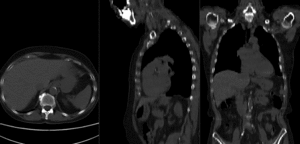 before registration (click to enlarge) before registration (click to enlarge)
|
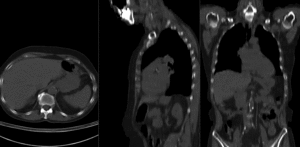 after affine+nonrigid registration (click to enlarge) after affine+nonrigid registration (click to enlarge)
|
 after affine+nonrigid registration (click to enlarge) after affine+nonrigid registration (click to enlarge)
|
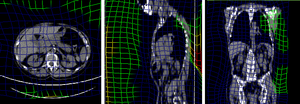 BSpline deformation grid (click to enlarge) BSpline deformation grid (click to enlarge)
|
